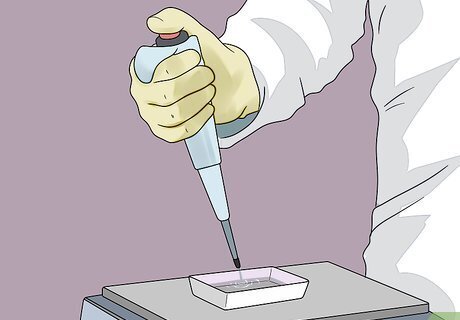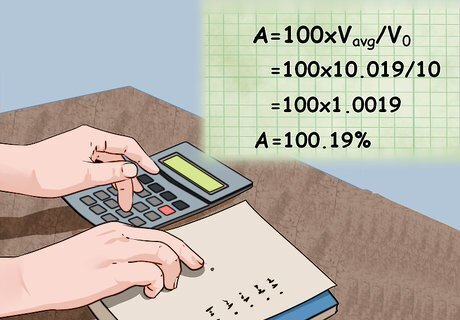
views
Checking the Calibration

Gather the necessary materials. To check the calibration of a pipette, you will need the pipette, pipette tips, distilled water, a beaker, a thermometer, a balance, and weigh boats. The balance needs to be specific to micrograms to calibrate micropipettes with a maximum of 1 µL. You won’t need more than 5 mLs of water. Fill the beaker with the water. Make sure the pipette tips are the correct tips that properly fit the pipette.

Measure the temperature of the distilled water. Place the thermometer in the water and leave it for at least one minute. If the red line on the thermometer is still moving, leave it for another minute. After a minute, record the temperature in a notebook. Remove the thermometer and dry it off when you are finished. Knowing the temperature of the water is important for the calculations that will be done to check the calibration.

Place the weigh boat on the balance and zero it out. Ideally, you will use a balance that has doors on it and is an isolated chamber. Place the weigh boat in the chamber and close the doors. If you don’t have doors, simply place the weigh boat on the balance. Press the “Zero” or “Tare” button and wait until the balance reads zero. Zeroing the scale subtracts the weight of the plastic boat and allows you to measure just the weight of whatever you put into the boat.

Prepare the pipette for calibration. Wipe down the pipette with ethanol to kill any contaminants before beginning and make sure nothing is clogging the tip end of the pipette. Place the appropriate tip on the end and set the volume that you want to test. For calibration, test both the smallest volume and the largest volume the pipette can dispense.

Pre-rinse the tip before calibration. Press the button to the first stop and stick the tip into the distilled water so that about 2 mm is immersed in the liquid. Release the button to aspirate some liquid and then dispense the liquid again by pushing the button down. Repeat this three times to pre-rinse the tip. Push the button to the second stop to dispense any liquid that remains in the tip and remove the pipette from the water.

Aspirate the calibration volume. With the tip out of the liquid, push the button down to the first stop. Place about 2 mm of the tip into the distilled water and release the button to aspirate the liquid into the tip. Wait about 1 second before removing the tip from the water. Make sure the tip is completely immersed during the whole aspiration process. You don’t want any bubbles in the tip or the results will be wrong.

Dispense the liquid into the weigh boat on the scale. Place the tip against the bottom of the weigh boat and push the button down to the first stop. Move to another spot slightly away from the water and push the button to the second stop. Keeping the button pressed, lift the tip away from the weigh boat. Keep the tip on the pipette as you will use it again to weigh out more calibration tests. MAke sure the tip does not touch anything.

Record the weight on the balance. Close the door if you are using a chamber balance. Wait until the numbers stop changing. Record this number in your notebook. It’s important to wait until the number has stabilized before recording it. Your readings will be incorrect if you don’t wait.

Repeat this process to take at least 10 readings. Zero the scale, pre-rinse the tip, aspirate the same volume, dispense the volume, and then record the weight. You want to have multiple recordings of the same volume and then you can average them all together. You can repeat this same process with different volumes as long as you take multiple readings per volume.
Calculating the Results

Define the formula for calculated volume. The formula for calculating the volume dispensed by the pipette is V = w * Z where w is the weight of the water, Z is the conversion factor based on the density of the water, and V is the calculated volume of how much water was dispensed. You can find the Z variable by looking up the density of water using the temperature recorded at the beginning of the experiment. For example: If the temperature of the water was 23°C, then you will use a Z value of 1.0035 µg/mg.

Average the replicates together. You should have weighed the volume of water dispensed by the pipette at least 10 times. In order to average all of these values together, add them all up and divide by 10. If you did more or fewer trials, add up each trial and divide by the total number of trials. For example: The ten weights you recorded for a pipette volume of 10µL are as follows: 9.89, 10.01, 10.02, 9.99, 9.95, 10.04, 9.96, 10.01, 9.99, and 9.98. The average is: (9.89 + 10.01 + 10.02 + 9.99 + 9.95+ 10.04 + 9.96 + 10.01 + 9.99 + 9.98)/10 = 99.84/10 = 9.984

Plug the variables into the equation and solve. Once you have determined the proper numbers to use for each variable, you can plug them into the equation and solve for the calculated volume. To solve, simply multiply the average weight of all the trials by the Z value. For example: V = w * Z = 9.984 * 1.0035 = 10.019

Calculate the accuracy of the pipette. To calculate the accuracy you can use the equation A = 100 x Vavg/V0, where A is the accuracy of the pipette, Vavg is the average calculated volume and V0 is the value you set the pipette to dispense. Accuracy should be between 99-101%. If the pipette is properly calibrated, the calculated value should be very close to the actual value you set on the pipette. For example: A = 100 x Vavg/V0 = 100 x 10.019/10 = 100 x 1.0019 = 100.19% This particular pipette is properly calibrated.

Send the pipette for calibration, if necessary. If your pipette does not pass the calibration test, stop using it for experiments immediately. Pipettes are very delicate and expensive pieces of lab equipment. You cannot fix the calibration yourself so you will need to send them in for proper servicing. Alternatively, some companies will come to your lab and calibrate your pipettes there Contact the company that makes your particular brand of pipette for servicing. Ensure the accuracy of delicate lab equipment. "As a lab tech, accurate tools are everything. When my pipettes started seeming "off," this guide saved me. Breaking calibration down into simple setups, step-by-step procedures, and number-crunching was genius! Now I feel confident I'm dispensing the right amounts thanks to the crystal clear instructions." - Sanchita M. Employ a consistent, meticulous calibration process. "Keeping variability out of my experiments matters big time. I love how this outlines a steady calibration workflow I can replicate precisely each month. Following the playbook for carefully gathering materials, handling tips, recording weights, etc., helps me be meticulous. Consistently maintaining tools this way gives me reliable, trustworthy data!" - Azhar U. Accessible guide empowers first-time calibrators. "As a total newbie, pipette calibration intimidated me! But the friendly photos and tips for each part dissolved my anxiety. Knowing how to check my work with the accuracy calculation gives me a safety net, too. I don't shy away from monthly maintenance now that it's laid out attractively for novices like me!" - Amit P. Leverage precision measurement fundamentals. "Entering a specialized field, I was shaky on some calibration fundamentals that pros take for granted. Going back to basics here gave me the fingerprints I needed, like temperature's effect on water density. Building this base understanding of core practices prevents doubtful measurements down the line. Feeling these core competencies boosted my calibration confidence enormously!" - Drew S. Did you know that wikiHow has collected over 365,000 reader stories since it started in 2005? We’d love to hear from you! Share your story here.


















Comments
0 comment